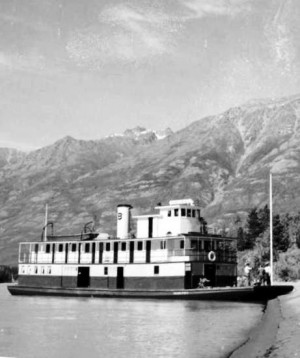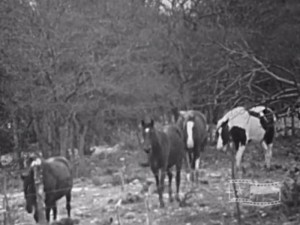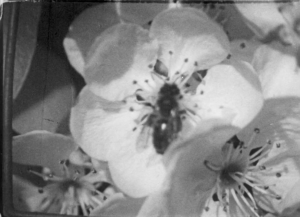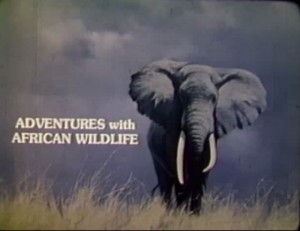"Film features trees and leaves, ducks, water, a statue, 2 women wearing coats, a bridge and some house-like structures. The garden was filmed in the spring/summer and fall" Archives of Ontario.
"One of these other films, showing a moose hunt, received an honorable mention. Thus Mr. Covert was the only contestant to receive two honors in the contest. His films revealed, besides brilliant photography, an unusual scenic sense. His films were no mere series of disjointed shots. In each case Mr. Cover told a story—and an interesting one" Photoplay, June 1928, 67.
"The principal award of $500 in the 16 millimeter division was awarded to B. V. Covert...for his remarkable study of a quail hunt and a number of beautiful pointers in action. Mr. Covert's photography was superb in this film and in two other contest contributions submitted for the consideration of the judges...His films revealed, besides brilliant photography, an unusual scenic sense. His films were no mere series of disjointed shots. In each case, Mr. Covert told a story—and an interesting one" Photoplay, June 1928, 67.
"In describing her film, Miss Bodine says: "I did all the camera work myself, using a Filmo double speed Camera, although some of the picture was taken using single speed. Most of the picture was made with a Taylor-Hobson Cooke lens, a 3 3-4 telephoto, the film being the regular Kodak safety stock. All of the work was done on a tiny porch of a summer cottage in Maine" Miss Bodine used small bottles, filled with sweetened water, to attract the humming birds before her camera." Photoplay, June 1928, 137.

"Mainly shows trip(s) up the Stikine by riverboat and placer mining activity [nearby]. Includes: waterfront view of Wrangell, Alaska; views of and from riverboat Hazel B No. 2 going upriver; the Three Sisters (islands in the river); riverboat at Telegraph Creek and barge at Dease Lake, and local activity; forest fire & fire-fighting; shots of Fokker F-11AHB flying boat designated CF-AUV (at dock and taking off) and a Fairchild floatplane; aerial shots in the vicinity; wreckage of aircraft CF-AUV (which crashed at McDame Lake, 13 July 1935); general scenery and wildlife. The placer mining footage, which is interspersed, includes shots of a small mining camp, sluice works, panning, hydraulic monitor operation, jerry-built mining equipment in use, etc. [The footage] was shot [ca. 1933-35] by Joseph J. Jackson, whose company "Three J's Placer Mines, Inc." prospected near the confluence of Thibert Creek with Dease Lake in [the years 1931-35]." (BC Archives)
"The chief 9 millimeter prize, of $500, was awarded to Clarence R. Underwood, of 3838 Kennerly Avenue, St. Louis, Mo. This was a well photographed and smoothly assembled study of the famous St. Louis Zoo" Photoplay, June 1928, 136.

"This amateur film chronicles several young ranchers in their day-to-day activities. The film is divided into six chapters, each highlighting a different theme. Setting the scene with shots of a river bend and surrounding cliffs, the movie shows two young men skipping stones by a creek. After playing around with rocks and a rope swing, they drive back to 141 Ranch. At the ranch, they take care of their cattle and spend quality time grooming and riding their horses. The last chapter introduces a strange boy, who startles one of the ranchers as he washes a frying pan outside. The film ends with the young men riding their horses towards the camera" Texas Archive of the Moving Image.

Documentary about bees, with impressive and detailed images. One of the best examples of the educational documentaries of the movement, which caught the attention of the Catalan Cinema Committee.
"The Adventures of Herman are not unlike those of Mickey Mouse, for although Herman may be of the same species, he is a bit bigger - just enough bigger to irritate the owner of the house in which he resides. Herman is about ten inches tall, and his movements, through single frame animation, are inter-cut with live action" PSA Journal, Aug. 1967, 36.

"In the summer of 1978, Robbins Barstow and his wife Meg, of Wethersfield, Connecticut, USA, took a four-week East African Safari Tour to Tanzania and Kenya, sponsored by the New York Zoological Society. This African wildlife adventure film includes scenes of 53 different species of animals and birds, filmed in the wild, among them Elephant, Giraffe, Rhino, Hippo, Lion, Leopard, Zebra, Wildebeest, Cheetah, and Impala." Archive.org
Total Pages: 19